Organisational Behaviour: Leadership Analysis of Jim's Library
VerifiedAdded on 2022/09/07
|8
|1321
|16
Report
AI Summary
This report analyses the leadership style of Jim, the senior librarian of a public library serving a community of 200,000 people. The report examines how Jim's supportive leadership approach, characterized by employee motivation, delegation, and a focus on individual strengths, has contributed to the library's success over six years. The analysis explores various leadership theories, including trait, behavioral, and situational contingency theories, to determine how Jim's style aligns with organisational behaviour concepts. The report highlights Jim's ability to identify and utilize the strengths of his staff, particularly Patti, to achieve organisational goals and maintain high customer satisfaction. The conclusion emphasizes the effectiveness of supportive leadership in fostering a positive work environment and achieving success in a public service context.
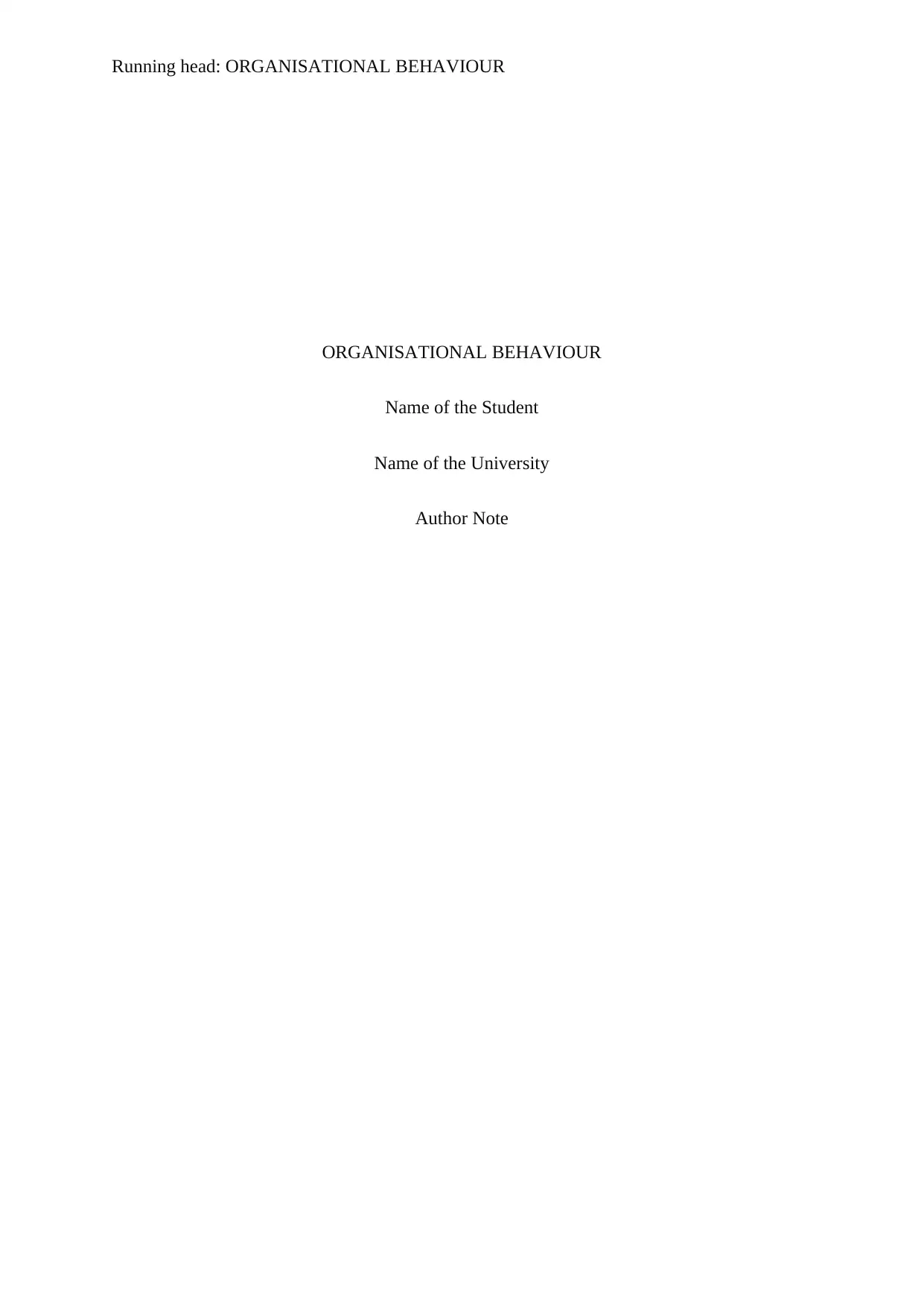
Running head: ORGANISATIONAL BEHAVIOUR
ORGANISATIONAL BEHAVIOUR
Name of the Student
Name of the University
Author Note
ORGANISATIONAL BEHAVIOUR
Name of the Student
Name of the University
Author Note
Paraphrase This Document
Need a fresh take? Get an instant paraphrase of this document with our AI Paraphraser
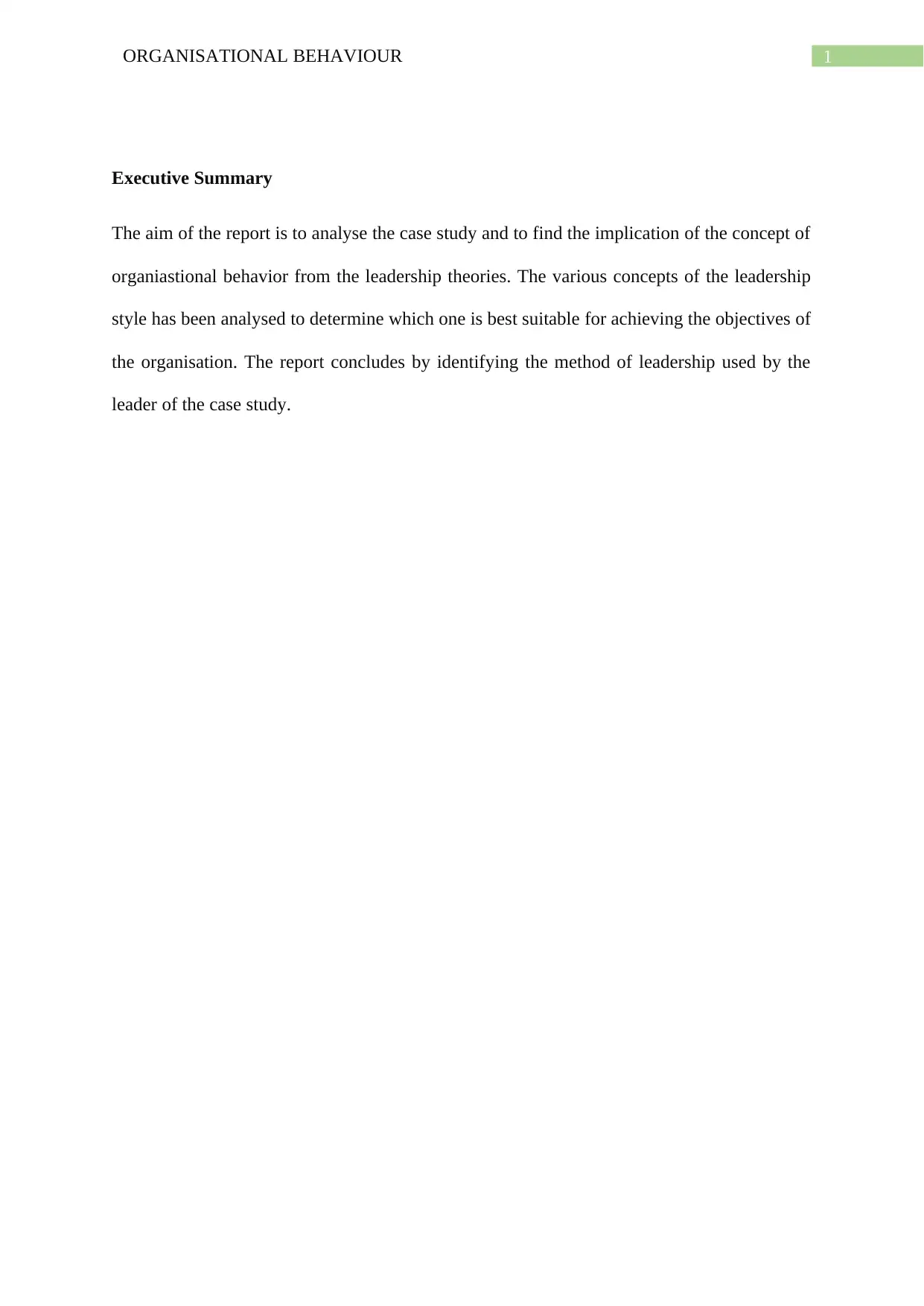
1ORGANISATIONAL BEHAVIOUR
Executive Summary
The aim of the report is to analyse the case study and to find the implication of the concept of
organiastional behavior from the leadership theories. The various concepts of the leadership
style has been analysed to determine which one is best suitable for achieving the objectives of
the organisation. The report concludes by identifying the method of leadership used by the
leader of the case study.
Executive Summary
The aim of the report is to analyse the case study and to find the implication of the concept of
organiastional behavior from the leadership theories. The various concepts of the leadership
style has been analysed to determine which one is best suitable for achieving the objectives of
the organisation. The report concludes by identifying the method of leadership used by the
leader of the case study.
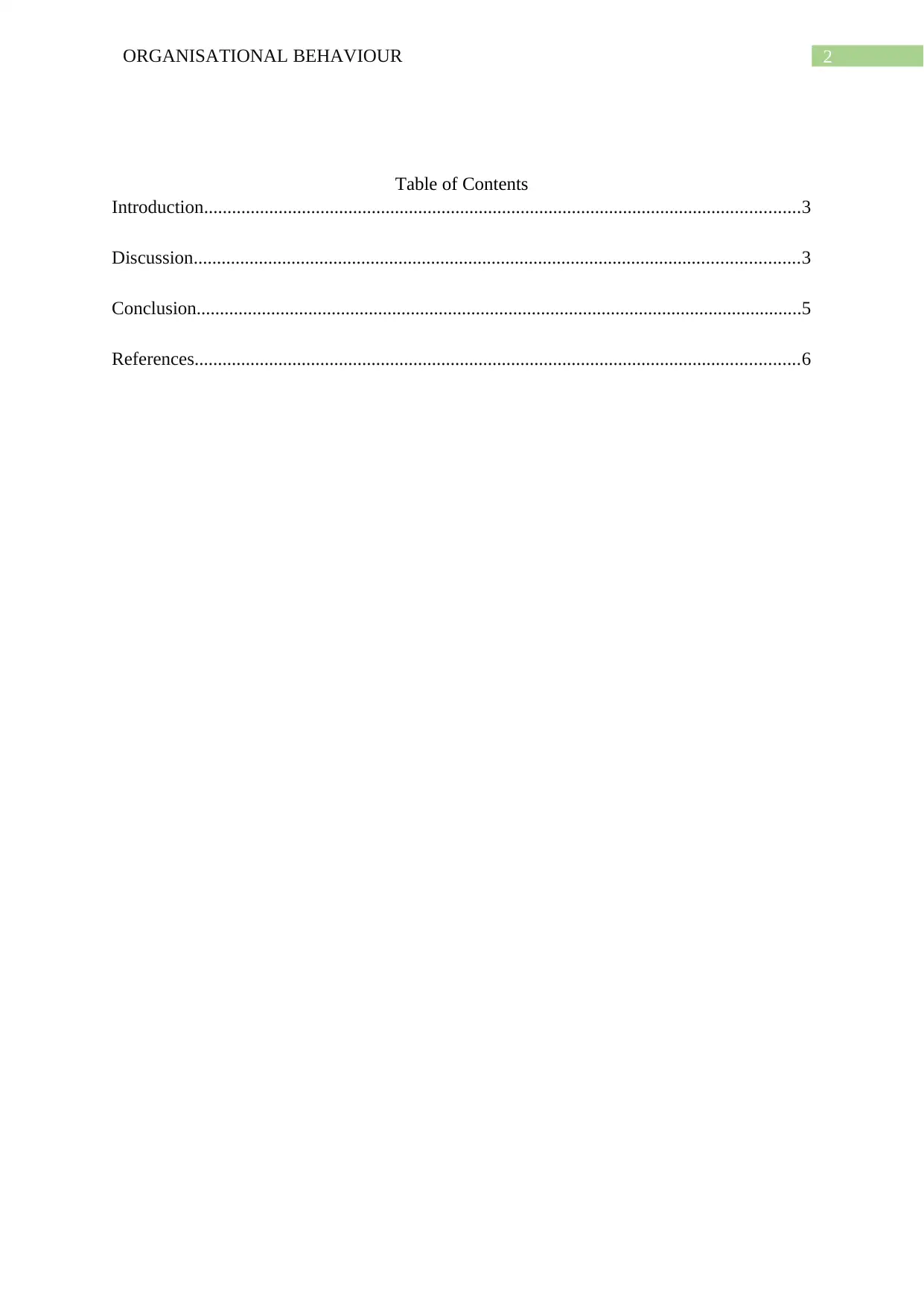
2ORGANISATIONAL BEHAVIOUR
Table of Contents
Introduction................................................................................................................................3
Discussion..................................................................................................................................3
Conclusion..................................................................................................................................5
References..................................................................................................................................6
Table of Contents
Introduction................................................................................................................................3
Discussion..................................................................................................................................3
Conclusion..................................................................................................................................5
References..................................................................................................................................6
⊘ This is a preview!⊘
Do you want full access?
Subscribe today to unlock all pages.

Trusted by 1+ million students worldwide
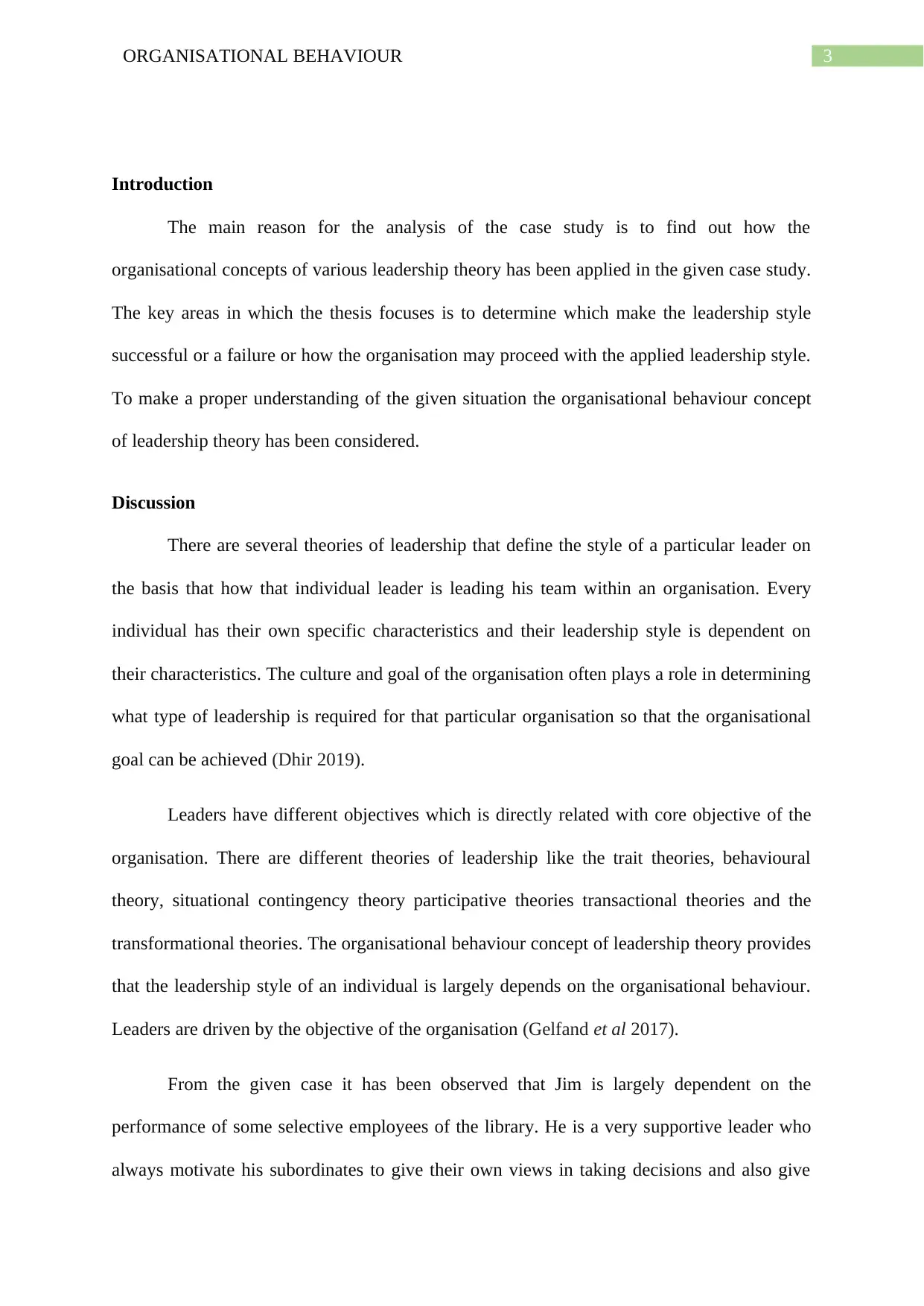
3ORGANISATIONAL BEHAVIOUR
Introduction
The main reason for the analysis of the case study is to find out how the
organisational concepts of various leadership theory has been applied in the given case study.
The key areas in which the thesis focuses is to determine which make the leadership style
successful or a failure or how the organisation may proceed with the applied leadership style.
To make a proper understanding of the given situation the organisational behaviour concept
of leadership theory has been considered.
Discussion
There are several theories of leadership that define the style of a particular leader on
the basis that how that individual leader is leading his team within an organisation. Every
individual has their own specific characteristics and their leadership style is dependent on
their characteristics. The culture and goal of the organisation often plays a role in determining
what type of leadership is required for that particular organisation so that the organisational
goal can be achieved (Dhir 2019).
Leaders have different objectives which is directly related with core objective of the
organisation. There are different theories of leadership like the trait theories, behavioural
theory, situational contingency theory participative theories transactional theories and the
transformational theories. The organisational behaviour concept of leadership theory provides
that the leadership style of an individual is largely depends on the organisational behaviour.
Leaders are driven by the objective of the organisation (Gelfand et al 2017).
From the given case it has been observed that Jim is largely dependent on the
performance of some selective employees of the library. He is a very supportive leader who
always motivate his subordinates to give their own views in taking decisions and also give
Introduction
The main reason for the analysis of the case study is to find out how the
organisational concepts of various leadership theory has been applied in the given case study.
The key areas in which the thesis focuses is to determine which make the leadership style
successful or a failure or how the organisation may proceed with the applied leadership style.
To make a proper understanding of the given situation the organisational behaviour concept
of leadership theory has been considered.
Discussion
There are several theories of leadership that define the style of a particular leader on
the basis that how that individual leader is leading his team within an organisation. Every
individual has their own specific characteristics and their leadership style is dependent on
their characteristics. The culture and goal of the organisation often plays a role in determining
what type of leadership is required for that particular organisation so that the organisational
goal can be achieved (Dhir 2019).
Leaders have different objectives which is directly related with core objective of the
organisation. There are different theories of leadership like the trait theories, behavioural
theory, situational contingency theory participative theories transactional theories and the
transformational theories. The organisational behaviour concept of leadership theory provides
that the leadership style of an individual is largely depends on the organisational behaviour.
Leaders are driven by the objective of the organisation (Gelfand et al 2017).
From the given case it has been observed that Jim is largely dependent on the
performance of some selective employees of the library. He is a very supportive leader who
always motivate his subordinates to give their own views in taking decisions and also give
Paraphrase This Document
Need a fresh take? Get an instant paraphrase of this document with our AI Paraphraser
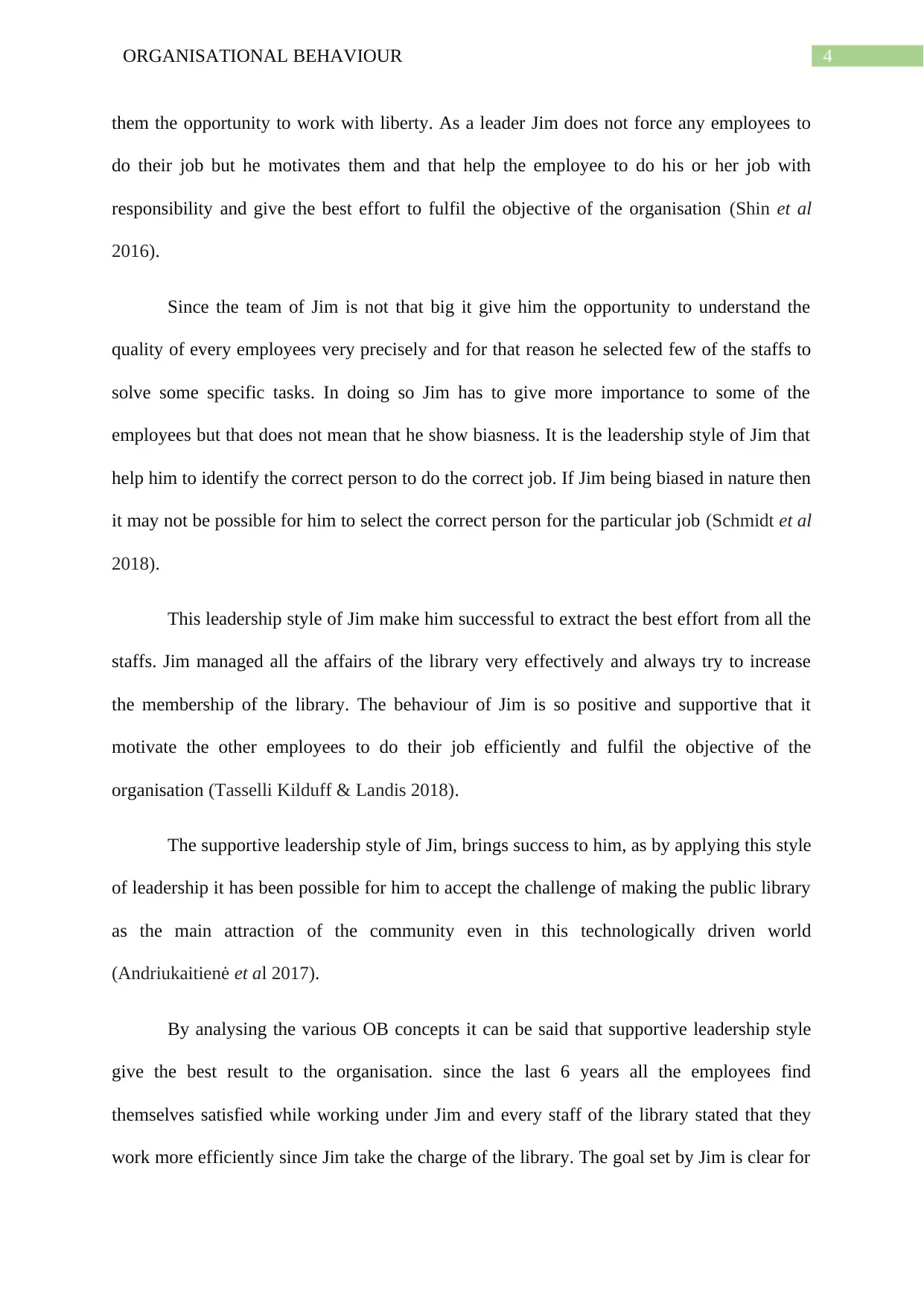
4ORGANISATIONAL BEHAVIOUR
them the opportunity to work with liberty. As a leader Jim does not force any employees to
do their job but he motivates them and that help the employee to do his or her job with
responsibility and give the best effort to fulfil the objective of the organisation (Shin et al
2016).
Since the team of Jim is not that big it give him the opportunity to understand the
quality of every employees very precisely and for that reason he selected few of the staffs to
solve some specific tasks. In doing so Jim has to give more importance to some of the
employees but that does not mean that he show biasness. It is the leadership style of Jim that
help him to identify the correct person to do the correct job. If Jim being biased in nature then
it may not be possible for him to select the correct person for the particular job (Schmidt et al
2018).
This leadership style of Jim make him successful to extract the best effort from all the
staffs. Jim managed all the affairs of the library very effectively and always try to increase
the membership of the library. The behaviour of Jim is so positive and supportive that it
motivate the other employees to do their job efficiently and fulfil the objective of the
organisation (Tasselli Kilduff & Landis 2018).
The supportive leadership style of Jim, brings success to him, as by applying this style
of leadership it has been possible for him to accept the challenge of making the public library
as the main attraction of the community even in this technologically driven world
(Andriukaitienė et al 2017).
By analysing the various OB concepts it can be said that supportive leadership style
give the best result to the organisation. since the last 6 years all the employees find
themselves satisfied while working under Jim and every staff of the library stated that they
work more efficiently since Jim take the charge of the library. The goal set by Jim is clear for
them the opportunity to work with liberty. As a leader Jim does not force any employees to
do their job but he motivates them and that help the employee to do his or her job with
responsibility and give the best effort to fulfil the objective of the organisation (Shin et al
2016).
Since the team of Jim is not that big it give him the opportunity to understand the
quality of every employees very precisely and for that reason he selected few of the staffs to
solve some specific tasks. In doing so Jim has to give more importance to some of the
employees but that does not mean that he show biasness. It is the leadership style of Jim that
help him to identify the correct person to do the correct job. If Jim being biased in nature then
it may not be possible for him to select the correct person for the particular job (Schmidt et al
2018).
This leadership style of Jim make him successful to extract the best effort from all the
staffs. Jim managed all the affairs of the library very effectively and always try to increase
the membership of the library. The behaviour of Jim is so positive and supportive that it
motivate the other employees to do their job efficiently and fulfil the objective of the
organisation (Tasselli Kilduff & Landis 2018).
The supportive leadership style of Jim, brings success to him, as by applying this style
of leadership it has been possible for him to accept the challenge of making the public library
as the main attraction of the community even in this technologically driven world
(Andriukaitienė et al 2017).
By analysing the various OB concepts it can be said that supportive leadership style
give the best result to the organisation. since the last 6 years all the employees find
themselves satisfied while working under Jim and every staff of the library stated that they
work more efficiently since Jim take the charge of the library. The goal set by Jim is clear for
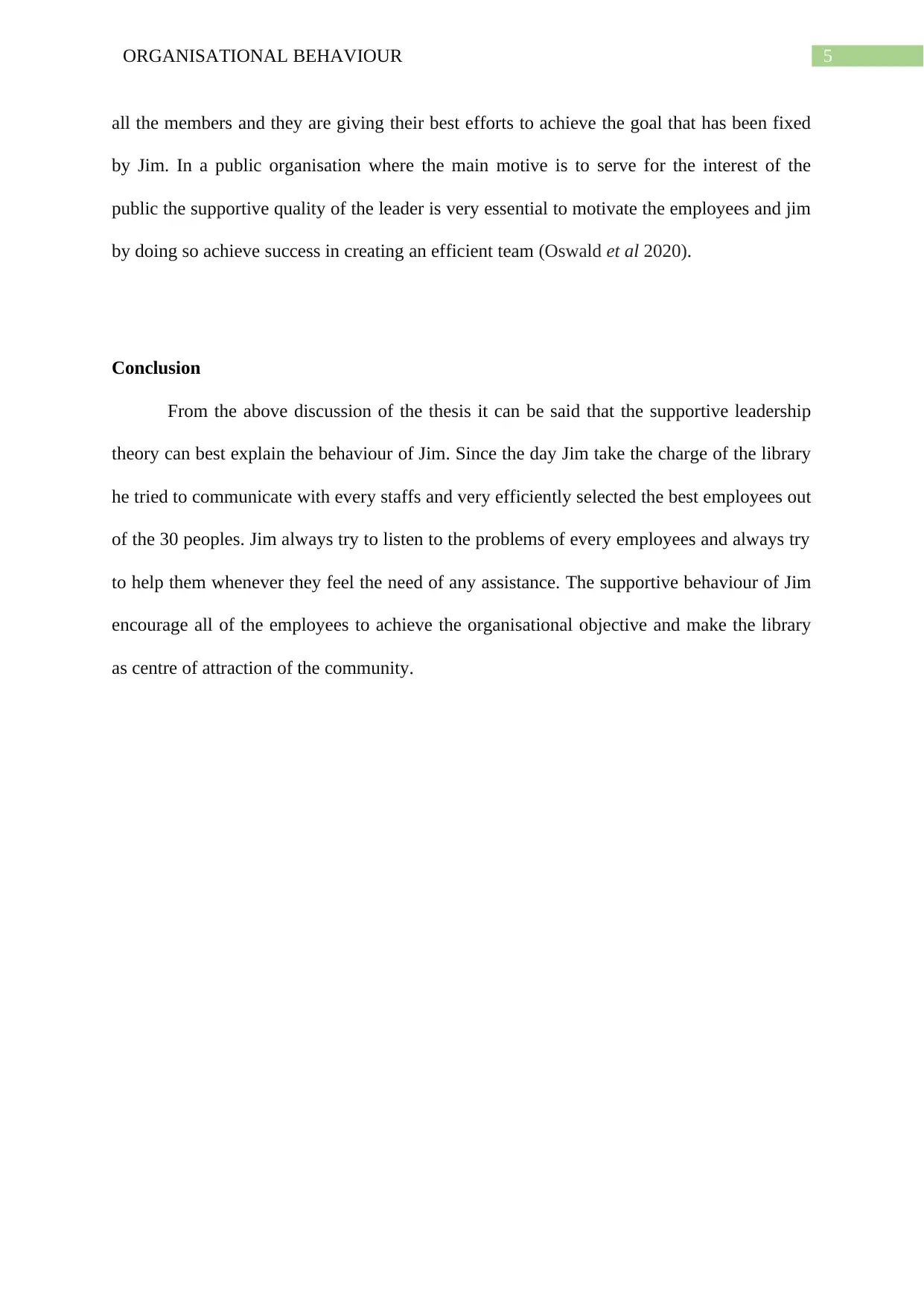
5ORGANISATIONAL BEHAVIOUR
all the members and they are giving their best efforts to achieve the goal that has been fixed
by Jim. In a public organisation where the main motive is to serve for the interest of the
public the supportive quality of the leader is very essential to motivate the employees and jim
by doing so achieve success in creating an efficient team (Oswald et al 2020).
Conclusion
From the above discussion of the thesis it can be said that the supportive leadership
theory can best explain the behaviour of Jim. Since the day Jim take the charge of the library
he tried to communicate with every staffs and very efficiently selected the best employees out
of the 30 peoples. Jim always try to listen to the problems of every employees and always try
to help them whenever they feel the need of any assistance. The supportive behaviour of Jim
encourage all of the employees to achieve the organisational objective and make the library
as centre of attraction of the community.
all the members and they are giving their best efforts to achieve the goal that has been fixed
by Jim. In a public organisation where the main motive is to serve for the interest of the
public the supportive quality of the leader is very essential to motivate the employees and jim
by doing so achieve success in creating an efficient team (Oswald et al 2020).
Conclusion
From the above discussion of the thesis it can be said that the supportive leadership
theory can best explain the behaviour of Jim. Since the day Jim take the charge of the library
he tried to communicate with every staffs and very efficiently selected the best employees out
of the 30 peoples. Jim always try to listen to the problems of every employees and always try
to help them whenever they feel the need of any assistance. The supportive behaviour of Jim
encourage all of the employees to achieve the organisational objective and make the library
as centre of attraction of the community.
⊘ This is a preview!⊘
Do you want full access?
Subscribe today to unlock all pages.

Trusted by 1+ million students worldwide
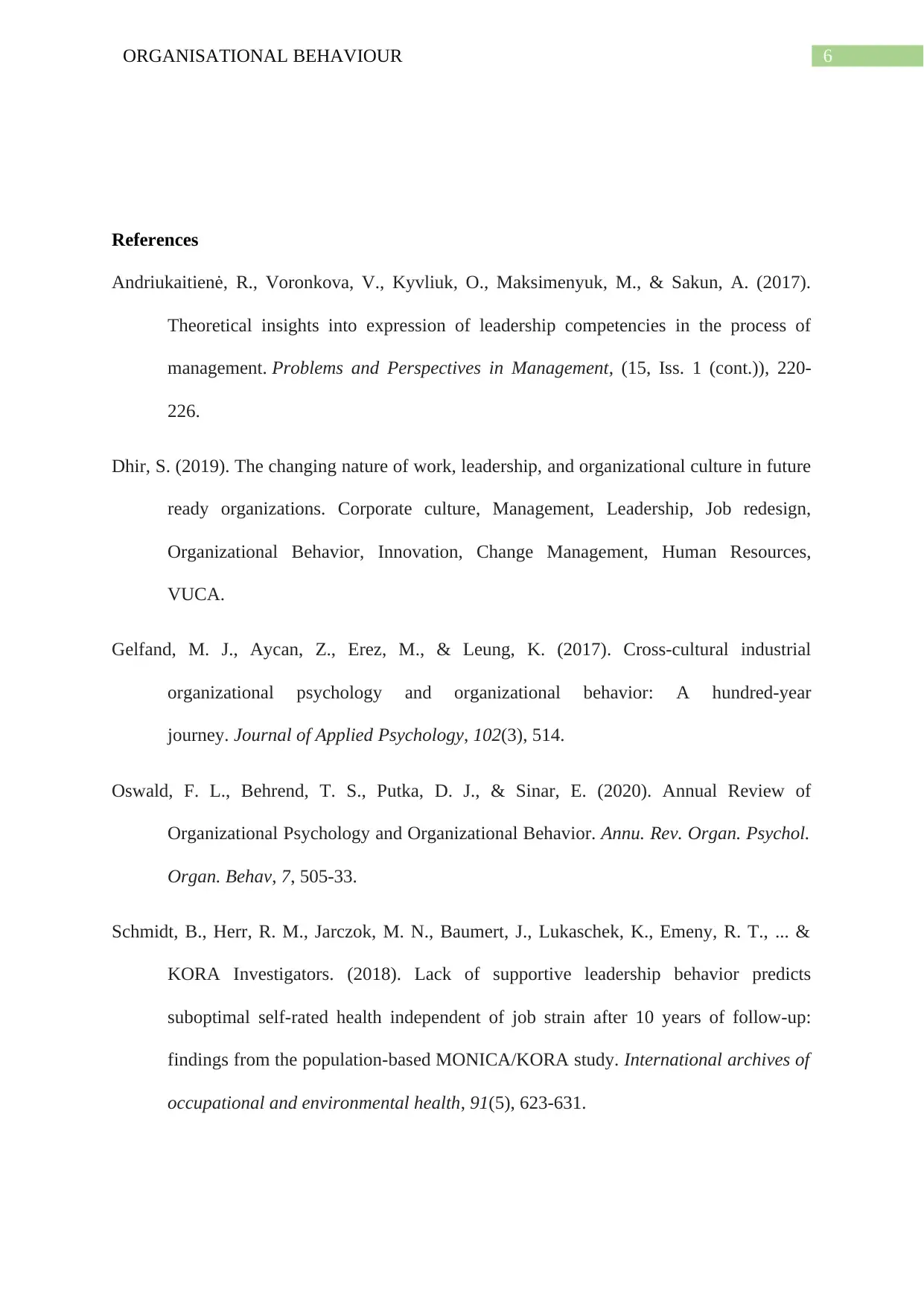
6ORGANISATIONAL BEHAVIOUR
References
Andriukaitienė, R., Voronkova, V., Kyvliuk, O., Maksimenyuk, M., & Sakun, A. (2017).
Theoretical insights into expression of leadership competencies in the process of
management. Problems and Perspectives in Management, (15, Iss. 1 (cont.)), 220-
226.
Dhir, S. (2019). The changing nature of work, leadership, and organizational culture in future
ready organizations. Corporate culture, Management, Leadership, Job redesign,
Organizational Behavior, Innovation, Change Management, Human Resources,
VUCA.
Gelfand, M. J., Aycan, Z., Erez, M., & Leung, K. (2017). Cross-cultural industrial
organizational psychology and organizational behavior: A hundred-year
journey. Journal of Applied Psychology, 102(3), 514.
Oswald, F. L., Behrend, T. S., Putka, D. J., & Sinar, E. (2020). Annual Review of
Organizational Psychology and Organizational Behavior. Annu. Rev. Organ. Psychol.
Organ. Behav, 7, 505-33.
Schmidt, B., Herr, R. M., Jarczok, M. N., Baumert, J., Lukaschek, K., Emeny, R. T., ... &
KORA Investigators. (2018). Lack of supportive leadership behavior predicts
suboptimal self-rated health independent of job strain after 10 years of follow-up:
findings from the population-based MONICA/KORA study. International archives of
occupational and environmental health, 91(5), 623-631.
References
Andriukaitienė, R., Voronkova, V., Kyvliuk, O., Maksimenyuk, M., & Sakun, A. (2017).
Theoretical insights into expression of leadership competencies in the process of
management. Problems and Perspectives in Management, (15, Iss. 1 (cont.)), 220-
226.
Dhir, S. (2019). The changing nature of work, leadership, and organizational culture in future
ready organizations. Corporate culture, Management, Leadership, Job redesign,
Organizational Behavior, Innovation, Change Management, Human Resources,
VUCA.
Gelfand, M. J., Aycan, Z., Erez, M., & Leung, K. (2017). Cross-cultural industrial
organizational psychology and organizational behavior: A hundred-year
journey. Journal of Applied Psychology, 102(3), 514.
Oswald, F. L., Behrend, T. S., Putka, D. J., & Sinar, E. (2020). Annual Review of
Organizational Psychology and Organizational Behavior. Annu. Rev. Organ. Psychol.
Organ. Behav, 7, 505-33.
Schmidt, B., Herr, R. M., Jarczok, M. N., Baumert, J., Lukaschek, K., Emeny, R. T., ... &
KORA Investigators. (2018). Lack of supportive leadership behavior predicts
suboptimal self-rated health independent of job strain after 10 years of follow-up:
findings from the population-based MONICA/KORA study. International archives of
occupational and environmental health, 91(5), 623-631.
Paraphrase This Document
Need a fresh take? Get an instant paraphrase of this document with our AI Paraphraser
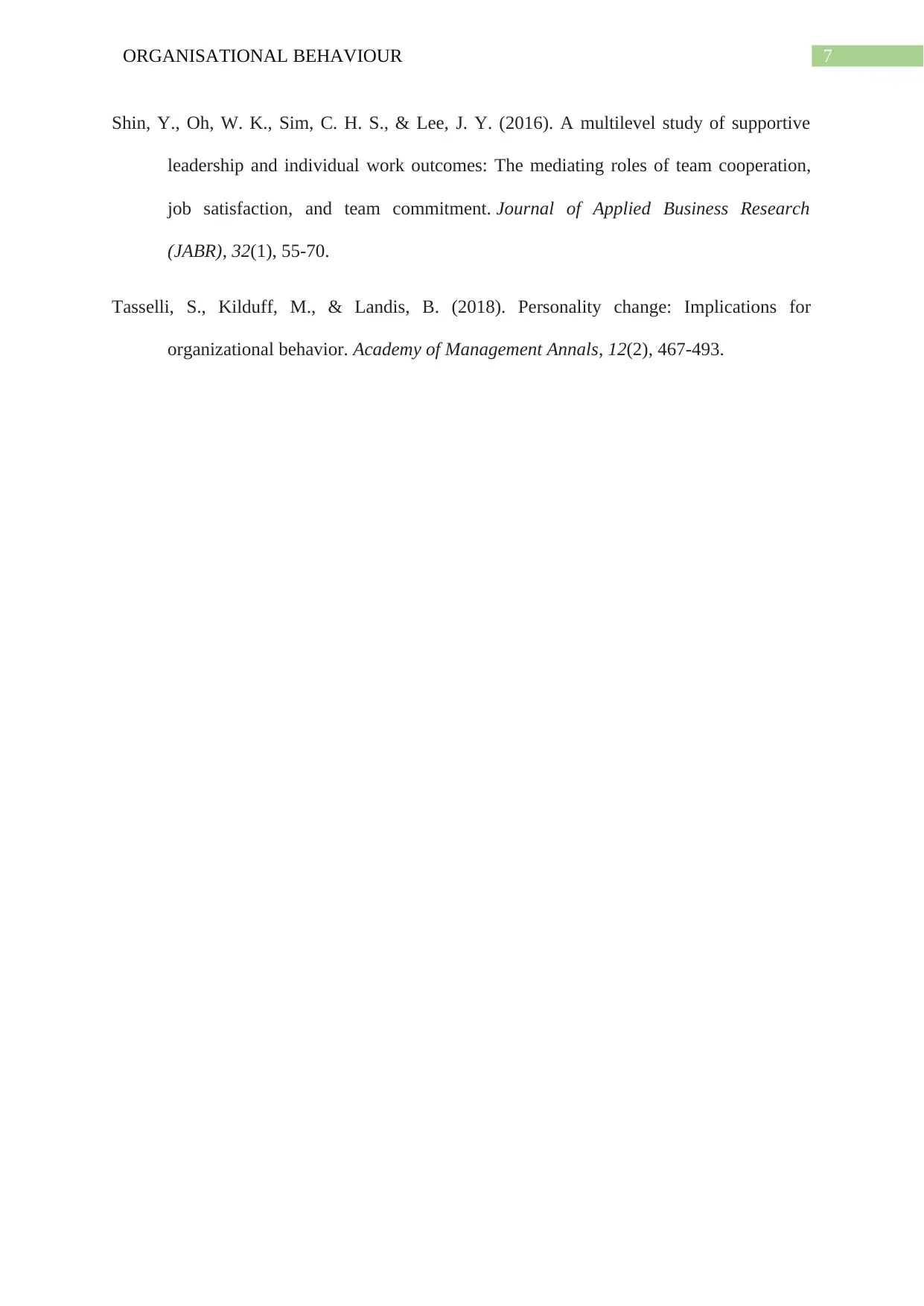
7ORGANISATIONAL BEHAVIOUR
Shin, Y., Oh, W. K., Sim, C. H. S., & Lee, J. Y. (2016). A multilevel study of supportive
leadership and individual work outcomes: The mediating roles of team cooperation,
job satisfaction, and team commitment. Journal of Applied Business Research
(JABR), 32(1), 55-70.
Tasselli, S., Kilduff, M., & Landis, B. (2018). Personality change: Implications for
organizational behavior. Academy of Management Annals, 12(2), 467-493.
Shin, Y., Oh, W. K., Sim, C. H. S., & Lee, J. Y. (2016). A multilevel study of supportive
leadership and individual work outcomes: The mediating roles of team cooperation,
job satisfaction, and team commitment. Journal of Applied Business Research
(JABR), 32(1), 55-70.
Tasselli, S., Kilduff, M., & Landis, B. (2018). Personality change: Implications for
organizational behavior. Academy of Management Annals, 12(2), 467-493.
1 out of 8
Related Documents
Your All-in-One AI-Powered Toolkit for Academic Success.
+13062052269
info@desklib.com
Available 24*7 on WhatsApp / Email
![[object Object]](/_next/static/media/star-bottom.7253800d.svg)
Unlock your academic potential
Copyright © 2020–2025 A2Z Services. All Rights Reserved. Developed and managed by ZUCOL.





